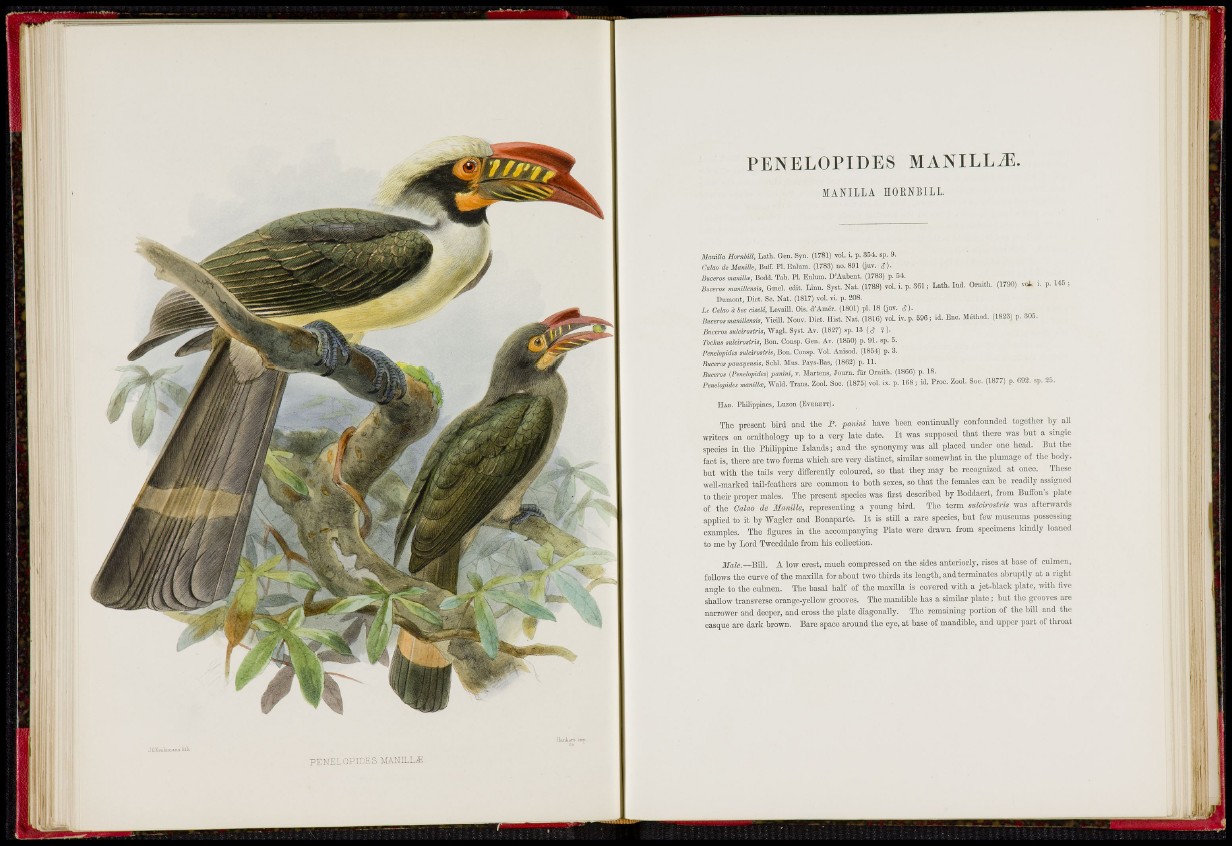
P F . N E L O P I R F . S MANILLA
PENELOPIDES MANILLiE.
MANILLA HOKNBILL
Manilla Hornbill, Lath. Gen. Syn. (1781) vol. i. p. 354. sp. 9.
Calao de Manille, Buff. Pl. Enlum. (1783) no. 891 i)-
Huceros maniUoe, Bodd. Tab. PI. Enlum. D'Aubent. (1783) p. 54.
Buceros manillenrn, Gmd. edit. Linn. Syst. Nat , (1788) vol. i. p. 361 ; Lath, Ind. Ornith. (1790) vai. p. 14.; ;
Dumont, Diet. Sc, Nat. (1817) vol, vi. p. 208.
Le Calao à bec ciselé, LovaiU. Ois, d'Amér. (1801) pl. 18 (juv.
fiuc^oBmanillemis, Vieiü, Nouv. Diet. Ilist. Nat. (1816) vol. iv. p. 59G; id. Enc. Method. (1823) p, 305.
Bucm>s sulcirostris, Wagl. Syst. Av. (1827) sp, 13 (cJ î ).
Tochus sulärostris, Bon. Consp, Gen. Av. (1850) p, 91- sp. 5.
Penelopides sulcirostris, Bon. Consp. Vol. Anisod. (1854) p. 3.
Buceros panayensis, Sclil, Mus. Pays-Bas, (1862) p. 11.
Buceros {Penelopides) panini, v. Martens, Journ. für Ornith. (1866) p. 18.
Penelopide^ manille. Wald. Trans. Zool. Soc. (1875) vol. ix. p. 168 ; id. Proc. Zool, Soc. (1877) p, 092, sp, 25.
IIAB. Philippines, Luzon (EVERETT).
The present bird and the P. paniui have continually confounded together by all
writers on ornithology up to a very late date. It was supposed that there was but a single
species m the PMKppine Islands; and the sjTionymy was all placed under one head. But thc'
fact is, there arc two forms which are very distinct, similar somewhat in the plumage of the body,
but with the tails Tery differently coloured, so that they may be recognized at once. Tliese
well-marked tail-feathers are common to both sexes, so that the females can be readily assigned
to their proper males. The present species was first described by Boddaert, from BuITon's plate
of the Calao de Manille, representing a young bird. The term auleirostris was afterwards
applied to it by "Wagler and Bonaparte. It is still a rare species, but few museums possessing
examples. The figures in the accompanying Plate were drawn from specimens kindly loaned
to me by Lord Tweeddale from his collection.
JfaZi,—Bill. A low crest, much compressed on the sides anteriorly, rises at base of culmcn,
foUows the curve of the maxilla for about two thirds its length, and terminates abruptly at a right
angle to the culmen. The basal half of the maxilla is covcred with a jet-black plate, with five
shallow transverse orange-yellow grooves. The mandible has a similar plate ; but the grooves arc
narrower and deeper, and cross the plate diagonally. The remaining portion of the bill and tlu^
casque are dark brown. Bare space around the eye, at base of mandible, and upper part of throat
Jy